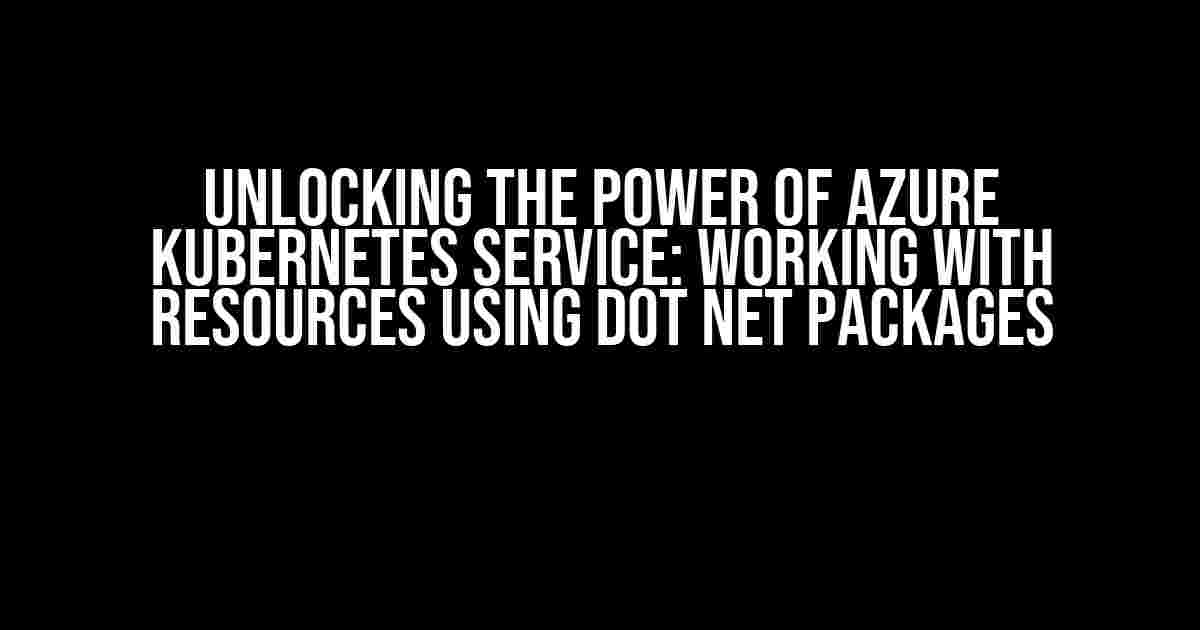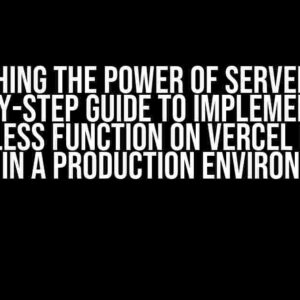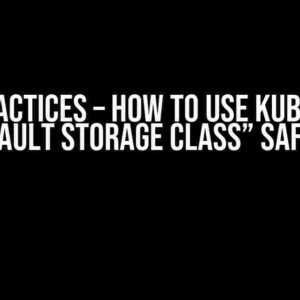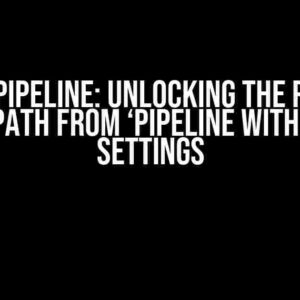Azure Kubernetes Service (AKS) is a powerful platform for deploying and managing containerized applications. As a .NET developer, you can leverage the capabilities of AKS to create scalable and efficient applications. However, working with resources inside AKS can be challenging, especially when it comes to managing and interacting with Azure resources. This is where Dot Net packages come into play.
What are Dot Net Packages?
Why Use Dot Net Packages with AKS?
There are several reasons why you should use Dot Net packages with AKS:
- Simplified Resource Management: Dot Net packages provide a unified API for interacting with Azure resources, making it easier to manage and interact with resources inside AKS.
- Improved Security: By using Dot Net packages, you can leverage Azure’s built-in security features, such as Azure Active Directory and Azure Key Vault, to secure your applications and data.
- Increased Efficiency: Dot Net packages provide a set of pre-built functions and classes that you can use to perform common tasks, such as storage and networking operations, reducing the amount of code you need to write.
- Better Integration: Dot Net packages provide a seamless integration with AKS, allowing you to focus on developing your application rather than worrying about the underlying infrastructure.
Which Dot Net Packages to Use with AKS?
There are several Dot Net packages that you can use with AKS, depending on your specific needs and requirements. Here are some of the most popular ones:
Azure.Core: Provides a set of core libraries for working with Azure services, including authentication, caching, and storage.Azure.Storage.Blobs: Provides a library for working with Azure Blob Storage, allowing you to upload, download, and manage blobs.Azure.Data Lake.Store: Provides a library for working with Azure Data Lake Storage, allowing you to interact with data lake files and directories.Azure.KeyVault: Provides a library for working with Azure Key Vault, allowing you to manage and use secrets, keys, and certificates.Azure.ContainerRegistry: Provides a library for working with Azure Container Registry, allowing you to manage and use container images.
How to Use Dot Net Packages with AKS?
To use Dot Net packages with AKS, you’ll need to follow these steps:
- Install the Package: Install the required Dot Net package using NuGet or another package manager.
- Import the Namespace: Import the namespace of the package in your .NET code.
- Authenticate with Azure: Authenticate with Azure using Azure Active Directory or another authentication mechanism.
- Use the Package APIs: Use the package APIs to interact with Azure resources, such as storage, networking, and security.
Example: Using Azure.Storage.Blobs with AKS
Here’s an example of how to use the Azure.Storage.Blobs package with AKS:
using Azure;
using Azure.Storage;
using Azure.Storage.Blobs;
namespace MyAksApp
{
public class BlobStorageController
{
private readonly BlobServiceClient _blobServiceClient;
public BlobStorageController(string storageAccountConnectionString)
{
_blobServiceClient = new BlobServiceClient(storageAccountConnectionString);
}
public async Task UploadBlobAsync(string containerName, string blobName, string filePath)
{
var containerClient = _blobServiceClient.GetBlobContainerClient(containerName);
var blobClient = containerClient.GetBlobClient(blobName);
using var fileStream = File.OpenRead(filePath);
await blobClient.UploadAsync(fileStream);
}
}
}
Best Practices for Using Dot Net Packages with AKS
Here are some best practices for using Dot Net packages with AKS:
- Use the Latest Version: Make sure to use the latest version of the Dot Net package to ensure you have access to the latest features and security updates.
- Follow Azure Security Guidelines: Follow Azure security guidelines and best practices to ensure the security of your application and data.
- Use Dependency Injection: Use dependency injection to inject the required Azure services and credentials into your application.
- Handle Errors and Exceptions: Handle errors and exceptions properly to ensure that your application can recover from failures and exceptions.
- Monitor and Log Performance: Monitor and log performance metrics to identify bottlenecks and optimize your application.
Conclusion
In this article, we’ve covered the importance of using Dot Net packages with AKS, the benefits of using these packages, and how to use them in your .NET applications. By leveraging the power of Dot Net packages, you can simplify the process of working with resources inside AKS and create more robust, efficient, and secure applications. Remember to follow best practices and stay up-to-date with the latest packages and Azure services to ensure the best possible experience.
| Dot Net Package | Description |
|---|---|
| Azure.Core | Provides a set of core libraries for working with Azure services |
| Azure.Storage.Blobs | Provides a library for working with Azure Blob Storage |
| Azure.Data Lake.Store | Provides a library for working with Azure Data Lake Storage |
| Azure.KeyVault | Provides a library for working with Azure Key Vault |
| Azure.ContainerRegistry | Provides a library for working with Azure Container Registry |
Remember to check the official Azure documentation and NuGet packages for the latest information and updates on using Dot Net packages with AKS.
Here are 5 Questions and Answers about “Dot Net packages to work with resources inside Azure Kubernetes service” in a creative voice and tone:
Frequently Asked Question
Get ready to dive into the world of Azure Kubernetes Service (AKS) and discover the best Dot Net packages to work with resources inside this powerful cloud-based container orchestration platform.
What is the most popular Dot Net package for working with Azure Kubernetes Service (AKS)?
The most popular Dot Net package for working with Azure Kubernetes Service (AKS) is the Azure Kubernetes Service (AKS) .NET client library, also known as `Microsoft.Azure.Kubernetes`. This package provides a set of .NET classes that allow you to interact with AKS clusters, deploy and manage applications, and perform operations on Kubernetes resources.
How can I use the `Microsoft.Azure.Kubernetes` package to deploy a .NET Core application to AKS?
To deploy a .NET Core application to AKS using the `Microsoft.Azure.Kubernetes` package, you can create a new instance of the `Kubernetes` class, authenticate with your AKS cluster, and then use the `Deploy` method to deploy your application as a Kubernetes deployment. You can also use the `CreateDeployment` method to create a new deployment and the `UpdateDeployment` method to update an existing one.
What is the difference between the `Microsoft.Azure.Kubernetes` package and the `k8s` package?
The `Microsoft.Azure.Kubernetes` package is a Azure-specific implementation of the Kubernetes API, while the `k8s` package is a generic implementation of the Kubernetes API that can be used with any Kubernetes cluster. The `Microsoft.Azure.Kubernetes` package provides additional features specific to Azure Kubernetes Service (AKS), such as support for Azure Active Directory (AAD) authentication and Azure Storage integration.
Can I use the `Microsoft.Azure.Kubernetes` package to manage Kubernetes resources in aDevOps pipeline?
Yes, you can use the `Microsoft.Azure.Kubernetes` package to manage Kubernetes resources in an Azure DevOps pipeline. You can create a .NET Core console application that uses the `Microsoft.Azure.Kubernetes` package to interact with your AKS cluster, and then use Azure DevOps to automate the deployment of your application and Kubernetes resources.
Is there a package that provides a simpler, more fluent API for working with Kubernetes resources in .NET?
Yes, there is a package called `FabricatedRoute` that provides a simpler, more fluent API for working with Kubernetes resources in .NET. This package provides a set of extension methods that allow you to work with Kubernetes resources using a more concise and expressive syntax.
I hope this helps! Let me know if you have any further requests.





